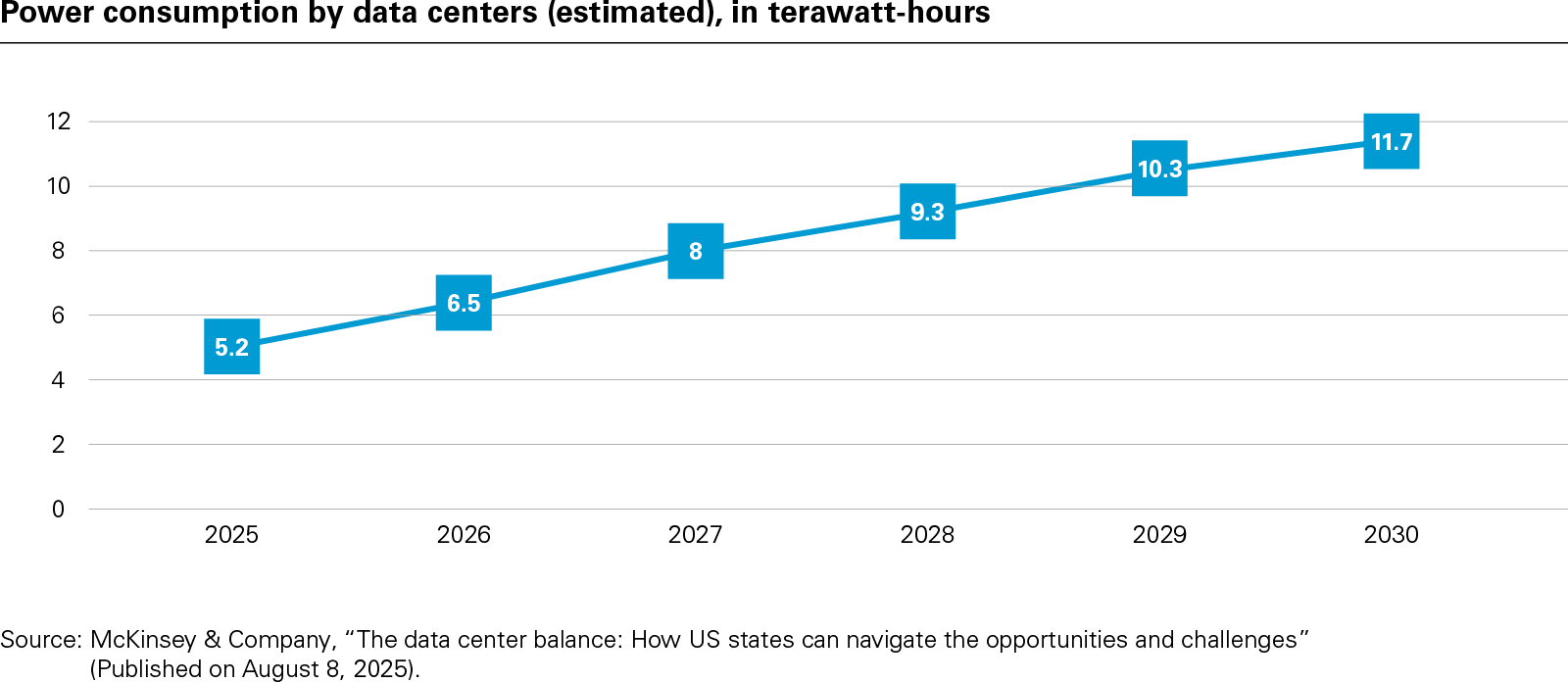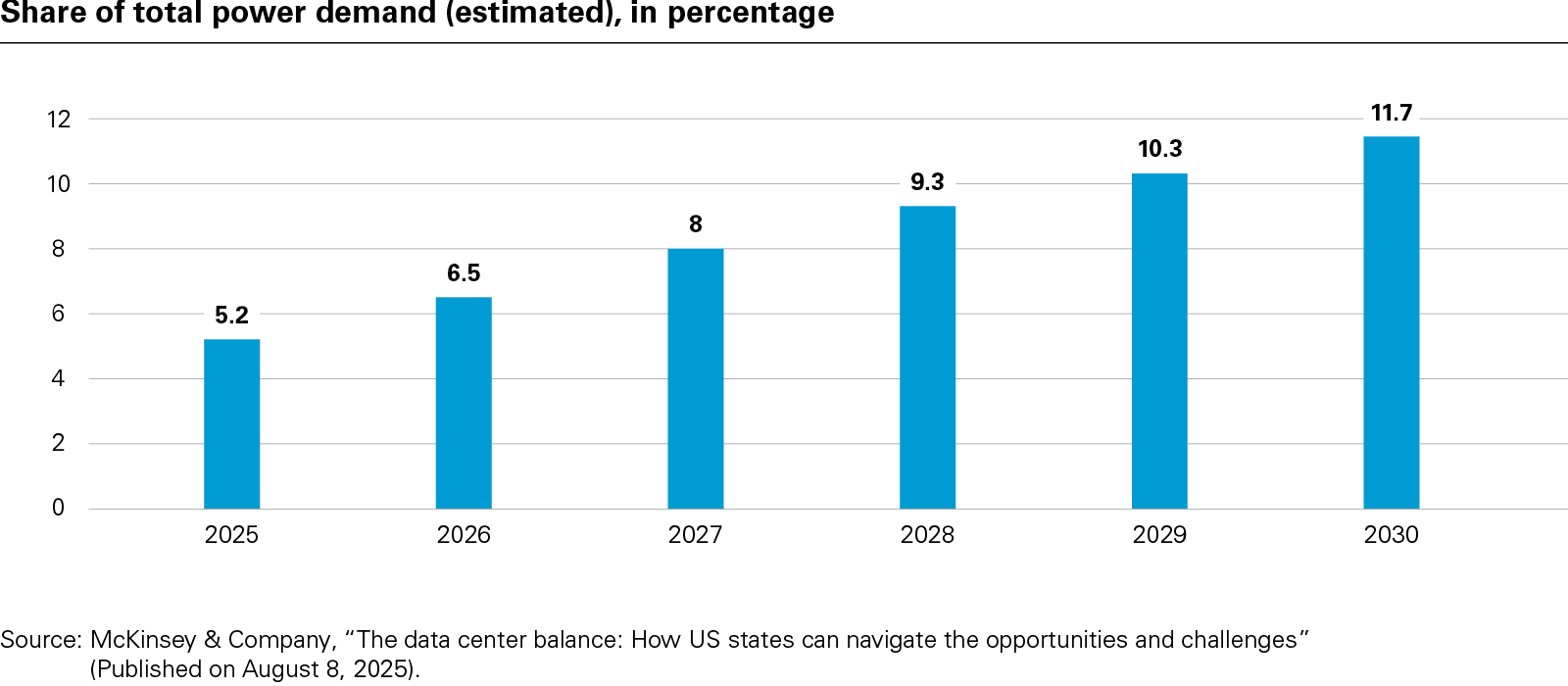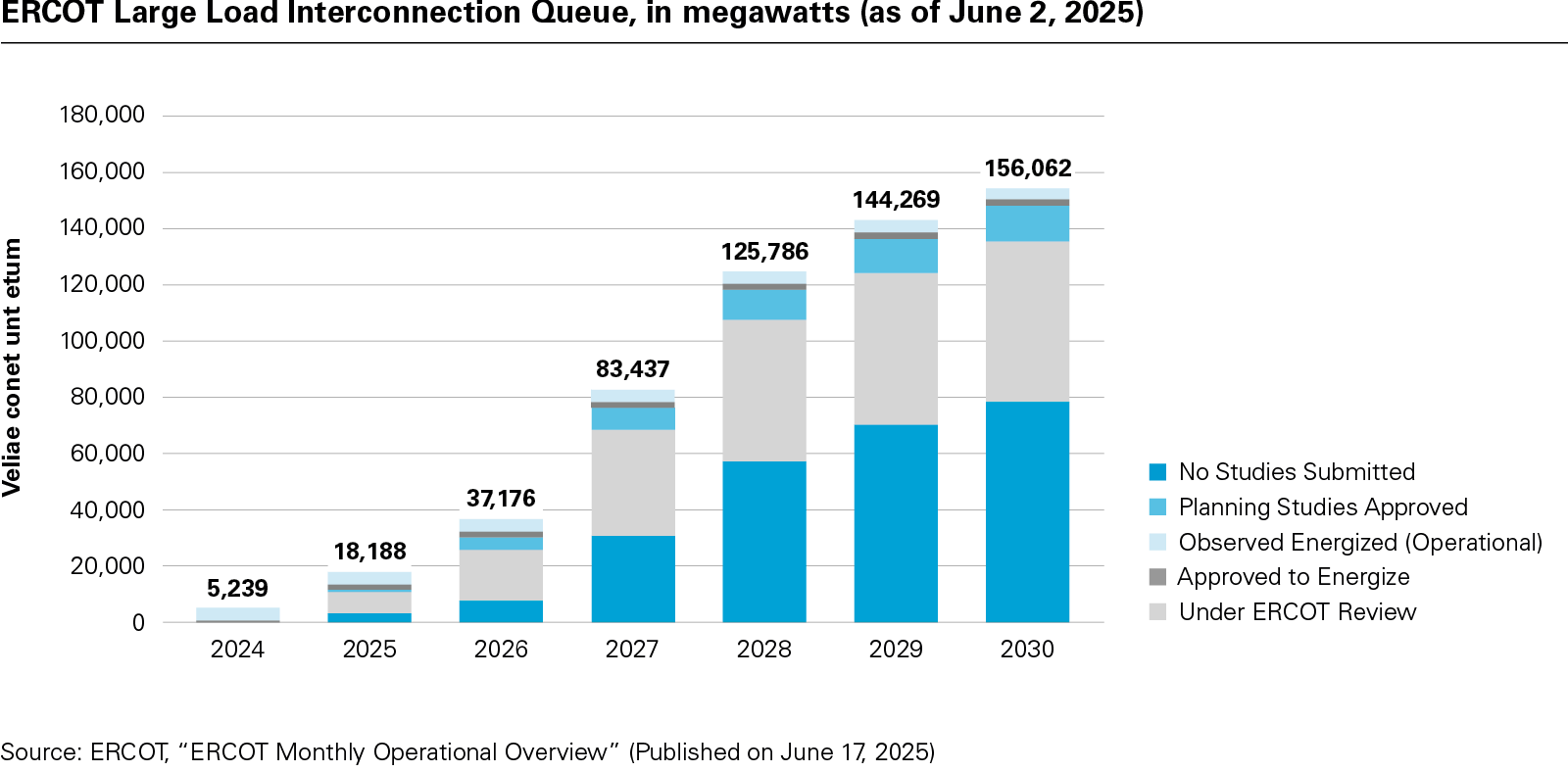
Grid operators propose innovative measures to manage electricity demand from data centers
9 min read
As the demand for artificial intelligence grows at a rapid pace, regional transmission organizations in the US are designing new solutions to connect data centers to the power grid.
Load Growth
Stemming from the expansive reach of artificial intelligence, grid operators are now projecting higher load growth forecasts in the coming years. The buildout of hyperscale data centers is now top of mind for many industry stakeholders as it presents both an opportunity (to encourage infrastructure investment) and a risk (to grid system reliability). While data centers are currently concentrated in certain geographic areas, new markets may yet emerge spurred on by state-level incentives, targeted policy instruments, or perhaps technological advancements.
In any estimation — regardless of where data centers are ultimately built — all US regional grid operators will need to accommodate this influx and develop a measure of regulatory certainty for sector participants. For additional context on the emerging federal regulatory approaches, particularly with respect to reliability and cost allocation, please refer to our prior articles: NERC Tees Up Plan to Assess Grid Risks Associated with Data Centers and FERC Orders Review of Co-Located Generation for Data Centers in PJM.
Within the past year, three of the regional transmission organizations have put forward unique proposals to interconnect data centers: PJM Interconnection, L.L.C. (PJM), Southwest Power Pool, Inc. (SPP), and Electric Reliability Council of Texas (ERCOT).
PJM
PJM is home to the most data centers in the country, largely in the northern Virginia portion of its 13-state footprint. According to its latest long-term load forecast, peak load in the region will grow by 32 gigawatts from 2025 to 2030; with data centers projected to comprise the vast majority (30 GW) in that period. The independent market monitor for PJM found that the "current tight conditions in the [PJM] capacity market are almost entirely the result of large data center load additions, both actual historical and forecast."2
Citing a need to address potential challenges to resource adequacy posed by the interconnection of large loads, the PJM Board of Managers announced a fast-track stakeholder process on August 8, 2025.3 The stakeholder process builds on prior efforts, including a workshop convened in May 2025, to incorporate large loads and data centers while ensuring sufficient and reliable electricity supply is available to ratepayers.
The main priorities, based on the PJM Board announcement, are likely to be as follows: resource adequacy (potentially requiring large loads to enter and clear Reliability Pricing Model auctions if the load is not backed by capacity); reliability criteria (establishing when certain actions for operational risks posed to the grid should be triggered and subsequently discontinued); interconnection rules (considering additional revisions to prioritize resource adequacy); and coordination (forging lines of communication and transparency with parties that enter into relevant contracts and arrangements, including large loads, states within PJM, and affected customers).
In an internal presentation given on August 18, 2025,4 PJM detailed three "pillars" to devise possible solutions:
- Non-Capacity-Backed Load (NCBL)
- New large load addition requests at or exceeding 50 megawatts will be eligible.
- NCBL would solicit voluntary participation in exchange for potential savings in capacity costs, given that PJM would credit units providing incremental supply ("Bring Your Own Generation") and demand response.
- Units under NCBL service would not be subject to capacity charges from the PJM Base Residual Auction.
- NCBL would encourage load flexibility as directed by PJM in order to maintain reliability under adverse conditions.
- The proposed new emergency action —to apply curtailment to NCBL units when necessary — would occur when PJM is unable to provide adequate capacity and cannot be relieved in any other way (i.e., transmission constraints).
- For settlement purposes, NCBL would be considered PJM Network Load and would be on the PJM transmission system without needing to schedule service.
- Priority interconnection pathways
- The existing (and recently reformed) interconnection queue process in PJM enables new service requests to be processed in a timely manner due to the "first-ready, first-served" cycle approach.
- Currently, large loads can choose several options such as: provisional service (to generate prior to the base case study year), surplus interconnection service (independent of the queue), or an upgrade request (to fully fund upgrades and commence construction in parallel to the queue process).
- The existing (and recently reformed) interconnection queue process in PJM enables new service requests to be processed in a timely manner due to the "first-ready, first-served" cycle approach.
- Demand response products
- PJM may evaluate adding a new class under Demand Response in order to match the capabilities of large loads (i.e., to reflect the limited duration and reliability of backup generation associated with a data center).
PJM intends to submit a proposal for NCBL to FERC by December 2025, with the goal to implement new rules by the 2028/2029 Base Residual Auction, effective June 1, 2028 . In accordance with a waiver request granted by FERC to delay the auction schedule, the 2028/2029 auction will now be held in May 2026.5 Given the magnitude of data centers concentrated within PJM, any effective and durable rules could serve as an example to other regional grid operators.
SPP
Despite a more modest portfolio of data centers as compared to PJM, a recent analysis found that SPP may host 7.3 percent of large loads nationally by 2030.6 As such, SPP has already contemplated that its existing interconnection procedures may not be sufficient to process large loads and conceded to a lack of flexibility for limited connection or operation of load within system limits.
On July 9, 2025, SPP released a proposal7 for "high-impact" large load customers (i.e., if peak demand is 50 MW or greater), under two specific initiatives:
Conditional High Impact Large Load Service (CHILLS)
- SPP proposed a new type of transmission service — for a timeframe of 1 to 5 years — available to large loads to transfer energy to designated delivery points.
- CHILLS customers will be expected to transition to firm transmission service within 5 years.
- Most notably, a large load customer enrolling in CHILLS would receive a completed interconnection study in 90 days.
- SPP outlined two scenarios in which this timeline will yield benefits: 1) If the transmission customer already has sufficient generation (or an agreement to secure generation), but does not have the transmission capacity to deliver energy to the load; or 2) if the transmission customer does not yet have sufficient generation and the load can accept limited service until such capacity is available.
- Large loads under CHILLS will be classified as non-market registered demand response in order to comply with SPP resource adequacy requirements.
- CHILLS are subject to curtailment under emergency conditions declared by SPP.
Generation-Supported HILL GI Assessment (HILLGA)
- Under this proposal, SPP will complete interconnection studies for both the new generation and the load it will serve in 90 days.
- SPP provided two scenarios for HILLGA: 1) If the transmission customer does not have sufficient generation or an agreement to serve the load; or 2) if the transmission customer has sufficient generation but prefers that the large load utilize different generation capacity.
- Generation can elect to be limited (to serve a local area) or pursue full interconnection service.
SPP aims to offer conditional service under CHILLS and HILLGA by the winter of 2025, pending approval of revisions to its Tariff by FERC.
ERCOT
Texas hosts abundant renewable energy generation in the form of solar and wind, but despite the amount of available capacity, there may be bottlenecks with respect to interconnecting large loads including data centers. Based on the current large load interconnection queue in ERCOT, just over 156 GW in new data centers will have been proposed by 2030.8
However, drawing from the one-year timeframe of June 2024 through June 2025, only approximately 3 GW of large load studies were approved. ERCOT closely scrutinizes large loads for reliability purposes, mandating that certain technical criteria are satisfied (i.e., steady sate, reactive power, dynamic stability, and so forth). Further, ERCOT requires that large loads enroll in fully firm service by undertaking and completing thermal upgrades, which is not a burden imposed on generators.
This mismatch between opportunity and outcome stands for the proposition that, while Texas has attracted both renewable generation and hyperscalers, the synergy between the two is not as efficient as it could be. Accordingly, the Texas state legislature passed Senate Bill 6 (SB6)9, which was signed into law on June 20, 2025 to be effective immediately.
SB6 addresses the interconnection rules and procedures for large loads — defined as 75 MW capacity or greater — in ERCOT. The most notable provisions are as follows:
- Financial Security
- To secure a spot in the interconnection queue, projects will be required to pay a study fee of at least $100,000 as well as demonstrate site control.
- Curtailment
- Starting in 2026, electric utilities in Texas will develop new protocols and install equipment in order to have the capability to remotely disconnect large loads during instances of firm load shed events.
- If a large load customer also has backup generation, ERCOT may calculate a threshold by which to call upon the customer to deploy electricity in the event of an emergency.
- Starting in 2026, electric utilities in Texas will develop new protocols and install equipment in order to have the capability to remotely disconnect large loads during instances of firm load shed events.
- Co-Location
- For large loads that interconnect to an existing generator (under a co-location arrangement from that point forward), net metering must be implemented.
- Co-located large load customers are responsible to dispatch the amount of generation equal to the unit through curtailment or deployment under an emergency condition.
- For large loads that interconnect to an existing generator (under a co-location arrangement from that point forward), net metering must be implemented.
- Reliability
- ERCOT will create a new reliability service in order to procure curtailment from large loads.
- Under this service, large load customers will be given at least 24 hours advance notice or due to anticipated extreme weather conditions.
- ERCOT will create a new reliability service in order to procure curtailment from large loads.
It is worth noting that SB6 did not provide for an expedited interconnection process for large loads, nor did it preemptively capture other operating requirements relating to power system reliability.
Outlook
In addition to the ongoing efforts discussed above and in our previous articles, there may be future opportunities to develop other solutions in the vein of standardized large load interconnection agreements, data sharing and reporting platforms for transparency and coordination, and accounting for the specific operational and technical characteristics of data centers connected to the grid. The collective efforts of regional transmission organizations, as well as by FERC and NERC, demonstrate the need for regulatory certainty in the near- and long-term.
1 McKinsey & Company, "The data center balance: How US states can navigate the opportunities and challenges" (Published on August 8, 2025).
2 Monitoring Analytics, LLC, "State of the Market for PJM - Q2 2025: January through June" (Published on August 14, 2025).
3 PJM Board of Managers, "PJM Board Letter Re: Implementation of Critical Issue Fast Path Process for Large Load Additions" (Published on August 8, 2025).
4 PJM Interconnection, L.L.C., "Large Load Additions: PJM Conceptual Proposal and Request for Member Feedback" (Presented on August 18, 2025). Available at: https://www.pjm.com/-/media/DotCom/committees-groups/cifp-lla/2025/20250818/20250818-item-03---pjm-conceptual-proposal-and-request-for-member-feedback---presentation.pdf.
5 189 FERC ¶ 61,105 at PP 6 (Issued on November 8, 2024). Available at: https://elibrary.ferc.gov/eLibrary/filelist?accession_number=20241108-3018.
6 Evolved Energy Research, "Future Load Scenarios for Southwest Power Pool" (September 2024). Available at: https://www.spp.org/documents/72773/future%20load%20scenarios%20for%20southwest%20power%20pool%20-%20evolved%20energy%20research%20-%202024.pdf.
7 Southwest Power Pool, SPP's High Impact Large Load Interconnection Solutions. Available at: https://spp.org/markets-operations/high-impact-large-load-hill-integration/.
8 ERCOT, "ERCOT Monthly Operational Overview" (Published on June 17, 2025). Available at: https://www.ercot.com/files/docs/2025/06/17/ERCOT-Monthly-Operational-Overview-May-2025.pdf.
9 Texas Legislature Online - 89(R) History for SB 6.
White & Case means the international legal practice comprising White & Case LLP, a New York State registered limited liability partnership, White & Case LLP, a limited liability partnership incorporated under English law and all other affiliated partnerships, companies and entities.
This article is prepared for the general information of interested persons. It is not, and does not attempt to be, comprehensive in nature. Due to the general nature of its content, it should not be regarded as legal advice.
© 2025 White & Case LLP

 View full image: Power consumption by data centers (estimated), in terawatt-hours (PDF)
View full image: Power consumption by data centers (estimated), in terawatt-hours (PDF)
 View full image: Share of total power demand (estimated), in percentage (PDF)
View full image: Share of total power demand (estimated), in percentage (PDF)
 View full image: ERCOT Large Load Interconnection Queue, in megawatts (as of June 2, 2025) (PDF)
View full image: ERCOT Large Load Interconnection Queue, in megawatts (as of June 2, 2025) (PDF)

